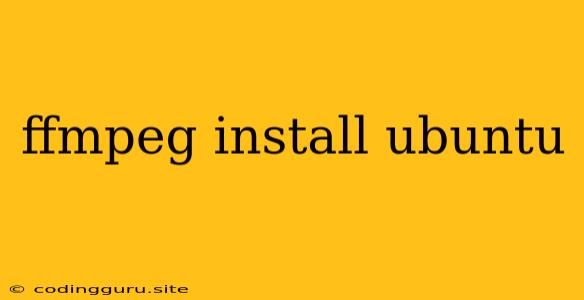FFmpeg Installation on Ubuntu: A Comprehensive Guide
Want to manipulate and process multimedia files like a pro? Look no further than FFmpeg, a powerful, open-source command-line tool that's indispensable for video and audio professionals. But how do you get it up and running on your Ubuntu system? This guide will walk you through the installation process, step by step.
Why Use FFmpeg?
FFmpeg is a versatile tool that can handle a wide range of tasks, including:
- Converting video and audio formats: Transform your videos from one format to another (e.g., MP4 to AVI, WAV to MP3).
- Editing video and audio: Trim, merge, and manipulate audio and video files.
- Adding subtitles and watermarks: Enhance your media with text overlays.
- Capturing live streams: Record streaming content for later viewing.
- Extracting audio from video: Isolate the soundtrack of your videos.
- Generating screenshots: Create snapshots of your videos at specific timestamps.
Installing FFmpeg on Ubuntu
The most straightforward way to install FFmpeg on Ubuntu is through the apt package manager. Here's a simple guide:
-
Open a terminal: Press Ctrl + Alt + T to launch the terminal.
-
Update the package list: Run the following command to ensure your system has the latest package information:
sudo apt update -
Install FFmpeg: Execute the command below to install FFmpeg:
sudo apt install ffmpeg -
Verify the installation: Once the installation is complete, run:
ffmpeg -versionYou should see the version information for FFmpeg displayed on your terminal.
Beyond the Basics: Exploring FFmpeg's Capabilities
Now that you've successfully installed FFmpeg, it's time to explore its vast capabilities. Let's delve into a few common examples:
1. Converting Video Formats:
To convert a video file from one format to another, use the following syntax:
ffmpeg -i input.mp4 output.avi
Replace input.mp4 with the name of your source file and output.avi with the desired output file name and format.
2. Extracting Audio from Video:
Extract the audio track from a video file like this:
ffmpeg -i input.mp4 output.mp3
This command will create an MP3 file named output.mp3 containing the audio from the video.
3. Creating Screenshots:
Capture a single frame from your video at a specific time using this command:
ffmpeg -i input.mp4 -ss 00:00:10 -vframes 1 output.jpg
Replace 00:00:10 with the desired time in the HH:MM:SS format.
4. Merging Multiple Videos:
Combine multiple video files into a single output file:
ffmpeg -i input1.mp4 -i input2.mp4 -i input3.mp4 -filter_complex "[0:v] [0:a] [1:v] [1:a] [2:v] [2:a] concat=n=3:v=1:a=1 [v] [a]" -map "[v]" -map "[a]" output.mp4
This command concatenates three video files (input1.mp4, input2.mp4, input3.mp4) into a single video named output.mp4.
5. Adding Watermarks:
Add a watermark to your video:
ffmpeg -i input.mp4 -i watermark.png -filter_complex "overlay=x=10:y=10" output.mp4
Replace watermark.png with the path to your watermark image. The x and y values determine the watermark's position on the video.
Troubleshooting
Sometimes, you might encounter errors during installation or while running FFmpeg commands. Here are a few troubleshooting tips:
- Check for typos: Ensure your commands are entered correctly, including file names and paths.
- Verify dependencies: Run
sudo apt install libavcodec-dev libavutil-dev libswscale-devif you face dependency issues. - Update your system: Always update your system regularly to ensure you have the latest versions of packages.
- Consult the official documentation: The official FFmpeg documentation () is a wealth of information, including a detailed list of commands and options.
Conclusion
FFmpeg is a versatile tool for multimedia processing, and its command-line interface grants you immense control. Installing FFmpeg on Ubuntu is a simple process thanks to the apt package manager. By exploring its numerous capabilities and leveraging its flexibility, you can unlock a world of possibilities for manipulating and enhancing your audio and video content.
